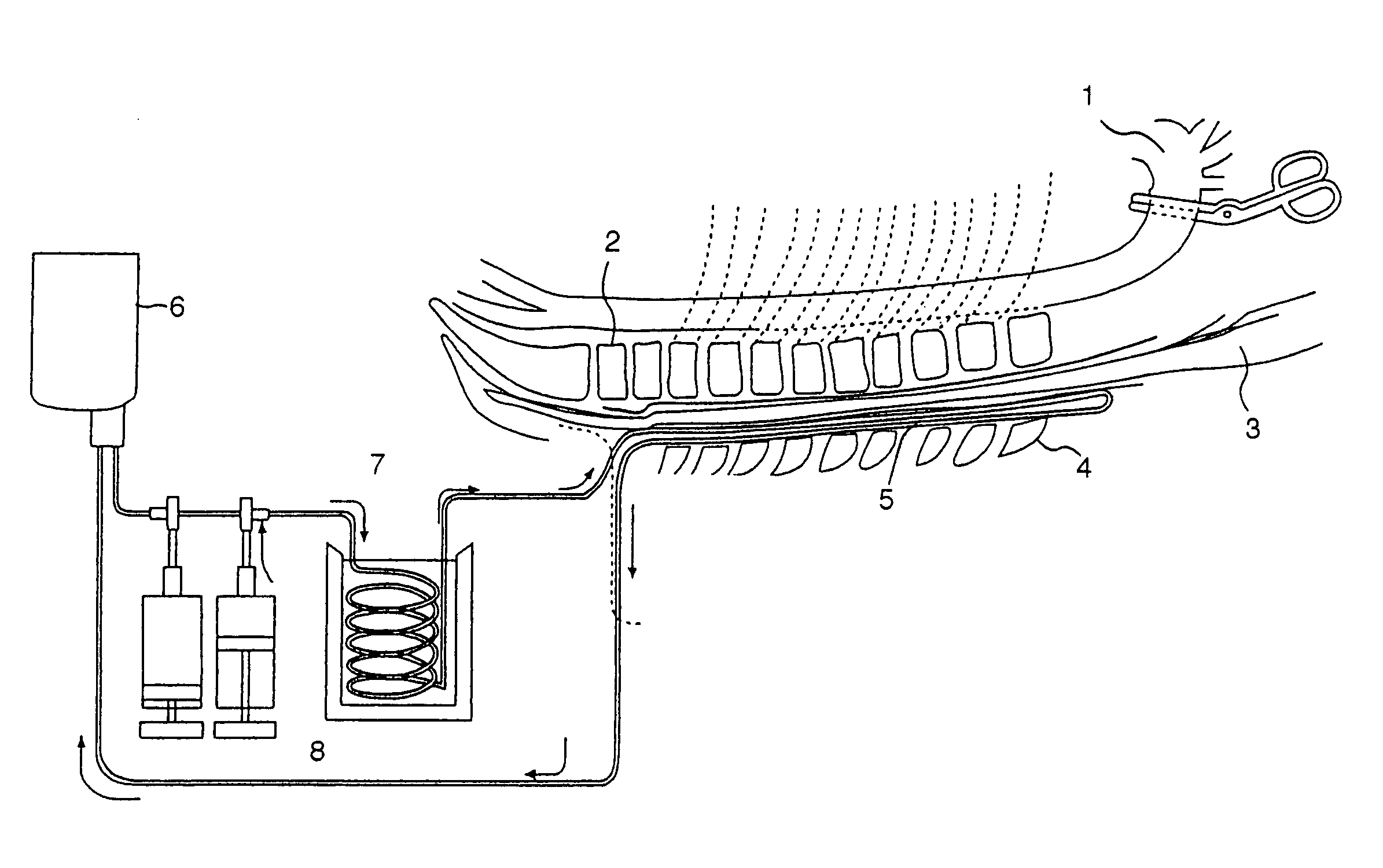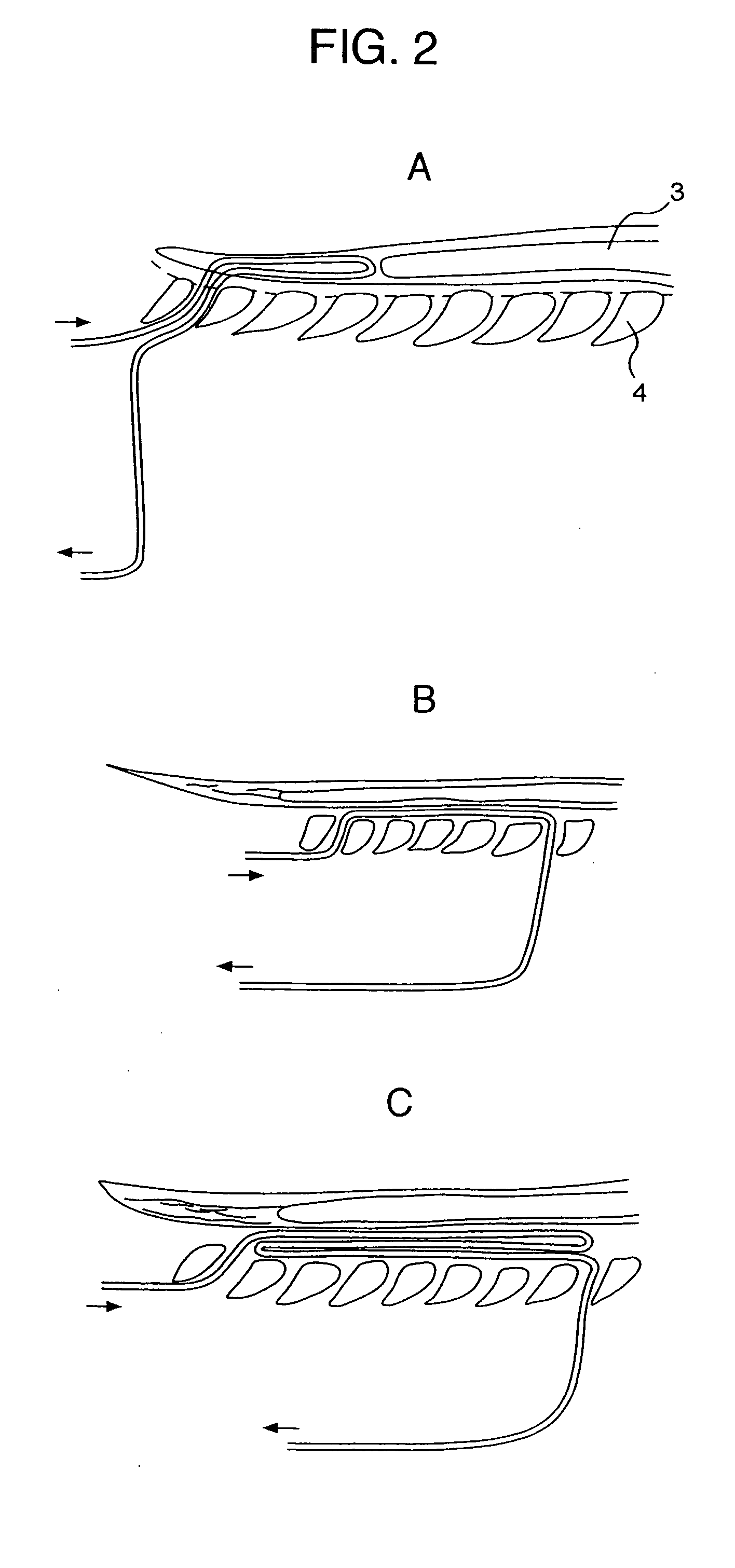Catheter for topical cooling and topical cooling device using the same
a cooling device and topical cooling technology, applied in the field of topical cooling and topical cooling devices, can solve the problems of difficult to specify the spinal root arteries, inability to effectively treat patients, and inability to cure patients,
- Summary
- Abstract
- Description
- Claims
- Application Information
AI Technical Summary
Benefits of technology
Problems solved by technology
Method used
Image
Examples
example 1
Cooling of the Spinal Cord using the Catheter of the Present Invention and a Device Using the Same and their Effects
[0045] The device of the present invention was applied to a porcine survival model in order to examine the effect of protecting the spinal cord. Thus, while blocking the descending aorta of a porcine survival model with a blocking clamp for 30 minutes, the device of the present invention was used in which the catheter was placed in the epidural cavity and distilled water was circulated through the catheter, the spinal cord was topical cooled, and the effect of protecting the spinal cord on the porcine survival model was evaluated by a neurological score. In the experiment, changes in the spinal cord somatosensory evoked potential (sSSEP) with time was monitored, and the effect of protecting the spinal cord was evaluated. sSSEP is an electrophysiological test of the spinal nerve termed as the spinal cord-induced potential, and specifically it is a test in which a stim...
example 2
Cooling of the Brain Using the Catheter of the Present Invention and a Device Using the Same and their Effects
[0066] An experiment was carried out in which during the operation of cerebral decompression, a catheter in a swirl form having no hole connecting to the epidural cavity was placed in the epidural cavity of the brain, and a cooling water was circulated through this catheter to absorb heat from the surface of the brain to topically cool the brain selectively and continuously.
1. Experimental Method
[0067] As the experimental animal, pigs weighing about 35-40 kg were used. After intramuscular injection of ketamine 15 mg / kg, a venous line was secured in the marginal ear vein. After a tracheal tube was inserted, controlled respiration was started using a respirator. For the maintenance of anesthesia, the depth of anesthesia was controlled with nitrous oxide and isoflurane. An arterial line was secured at the right axillary artery and electrocardiogram (ECG) was continuously m...
example 3
Cooling of the Esophagus Using the Catheter of the Present Invention and a Device Using the Same and their Effects
[0072] An experiment was carried out in which a U-shaped catheter having no hole connecting to the esophagus cavity was orally placed in the esophagus, and a cooling water was circulated through this catheter to absorb heat from the surface of the esophagus to topically cool the esophagus selectively and continuously.
1. Experimental Method
[0073] As the experimental animal, pigs weighing about 35-40 kg were used. After intramuscular injection of ketamine 15 mg / kg, a venous line was secured in the marginal ear vein. After a tracheal tube was inserted, controlled respiration was started using a respirator. For the maintenance of anesthesia, the depth of anesthesia was controlled with nitrous oxide and isoflurane. An arterial line was secured at the right axillary artery and blood pressure was monitored. By monitoring an electrocardiogram continuously, the temperature o...
PUM
 Login to View More
Login to View More Abstract
Description
Claims
Application Information
 Login to View More
Login to View More - R&D
- Intellectual Property
- Life Sciences
- Materials
- Tech Scout
- Unparalleled Data Quality
- Higher Quality Content
- 60% Fewer Hallucinations
Browse by: Latest US Patents, China's latest patents, Technical Efficacy Thesaurus, Application Domain, Technology Topic, Popular Technical Reports.
© 2025 PatSnap. All rights reserved.Legal|Privacy policy|Modern Slavery Act Transparency Statement|Sitemap|About US| Contact US: help@patsnap.com



